Kanafeh
Kanafeh (Arabic: كُنافة, [kʊˈnaːfa] (![]()
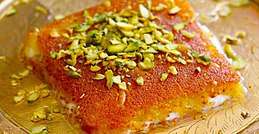 Kanafeh Nabulsieh from Nablus | |
| Alternative names | kunafeh, kunafa, knafeh, konafi, etc. |
|---|---|
| Type | Dessert |
| Place of origin | Middle East[1][2] |
| Region or state | Levant, Arab world, Turkey, Southeast Europe, South Caucasus |
| Serving temperature | Hot |
| Main ingredients | Dough, sugar, cheese, almonds, pistachios, rose water, kaymak, etc. |
| Variations | Multiple |
In Arabic, kunāfa may refer to the string pastry itself, or to the entire dessert dish. In Turkish, the string pastry is known as tel kadayıf, and the cheese-based dessert that uses it as künefe. In the Balkans, the shredded dough is similarly known as kadaif,[7] and in Greece as kataifi, and is the basis of various dishes rolled or layered with it, including dessert pastries with nuts and sweet syrups.
One of the most well-known preparations of kanafeh is knafeh nabulsiyeh, which originated in the Palestinian city of Nablus,[8] and is the most representative and iconic Palestinian dessert.[9][10] Knafeh nabilsiyeh uses a white-brine cheese called Nabulsi.[11][12] It is prepared in a large round shallow dish, the pastry is colored with orange food coloring, and sometimes topped with crushed pistachio nuts.
Etymology
The English language borrows the word from Levantine or Egyptian Arabic, and may employ numerous different spellings, such as kanafeh, kenafeh, knafeh, kunafah, kunafeh, konafa, kunafa, and similar variations.[13][14]
The Arabic word kunāfa (Arabic: كنافة) comes from the Coptic Egyptian word kenephiten, a bread or cake.[2][15][13][16] Early attestations are found in Iraqi stories in Alf laylaẗ wa-laylaẗ, the One Thousand and One Nights.[13] Another view is that it comes from a Semitic root with a meaning of side or wing, from the Arabic kanafa, to flank or enclose.[17][18] According to etymologist Sevan Nişanyan, the Turkish word tel kadayıfı (string-pancake or string-crêpe), referring to the vermicelli-like pastry used in kanafeh and other dishes, is based on the Arabic word qatayif (a pancake or crêpe), and appears at the latest in 1501 in a Turkish-Persian dictionary.[19]
History
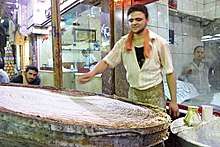
A common story is that the dish was created, and prescribed by doctors, to satisfy the hunger of caliphs during Ramadan. The story is variously said to have happened in Fatimid Egypt, or in the Umayyad Caliphate in Syria.[20] It is also reported to have been mentioned in writing as early as the 10th century, and to be of Fatimid origin.[21][22][23] However, dishes mentioned in historical texts are not necessarily the same as the modern versions of kanafeh.
Ibn Sayyar al-Warraq's 10th-century Kitab al-Tabikh (Book of Dishes), a collection of Arabic and Persian recipes and food advice of the Abbasid caliphs, mentions neither the word kunāfa, nor a description of the dish as it is known today. However, it does feature a chapter on desserts made with the related qatāyif, meaning crêpes, from which the Turkish word kadayıf and Greek word kataïfi derive. In one recipe, qatāyif are stuffed with nuts, deep-fried, and topped with honey-sugar syrup, which is essentially unchanged in today's version. Also described are large thin crêpes resembling fabric, called ruqāq, cooked on a round sheet of metal called a tābaq, layered with fruit, and drenched with sugar.[24][1]
The 13th-century anonymous Kitab al tabikh fi-l-Maghrib wa-l-Andalus (Book of Dishes from Mahgreb and Al-Andalus) uses the word kunāfa to describe a crêpe made with thin batter on an Indian pan or "mirror" (the tābaq), and says it is equivalent to ruqāq. It also gives a recipe for Abbasid Qatāyif (the crêpes being called musahhada in Al-Andalus), which uses the same batter, but the kunāfa is made thinner, "like a fine tissue". It gives a number of dessert recipes for kunāfa, where the crêpes are served layered with fresh cheese, baked, and topped with honey and rose syrup; or cut up into shreds like rose leaves and cooked with honey, nuts, sugar, and rosewater.[25][1]
Ibn al-Jazari gives an account of a 13th-century market inspector who rode through Damascus at night, ensuring the quality of kunāfa, qatā'if, and other foods associated with Ramadan, during the Mamluk period.[26]
In the later Middle Ages, a new technique was created, with thin batter being dripped onto the metal sheet from a perforated container, creating hair-like strings. A mid-15th-century Ottoman Turkish translation of Muhammad bin Hasan al-Baghdadi's Kitab al-Tabikh added several new contemporary recipes, including one for this kadayif, though it does not specify where it originated.[27] This became the basis for the modern kunafa/kanafeh. It is fried together with butter and fillings or toppings such as nuts, sweetened cheese, or clotted cream, and mixed with rosewater and sugar. The pastry spread from the Arab lands to neighboring countries including Iran and Greece, and to Turkey where the string pastry itself is known as tel kadayıf ("string crêpes"), also used in related pastries such as dolma kadayif.[1]
Preparation
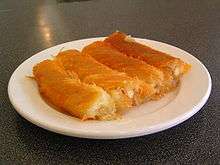
There are many types of Kanafeh pastry:[28]
- khishnah (Arabic: خشنة, rough): crust made from long thin noodle threads.
- na'ama (Arabic: ناعمة, fine): semolina dough.
- mhayara (Arabic: محيرة, mixed): a mixture of khishnah and na'ama.
- mbrwma (Arabic: مبرومة, twined): It is prepared with noodle.
The pastry is heated in butter, margarine, palm oil, or traditionally semneh and then spread with soft white cheese, such as Nabulsi cheese, and topped with more pastry. In khishnah kanafeh the cheese is rolled in the pastry. A thick syrup of sugar, water, and a few drops of rose water or orange blossom water is poured on the pastry during the final minutes of cooking. Often the top layer of pastry is tinted with red food coloring (a modern shortcut, instead of baking it for long periods of time). Crushed pistachios are sprinkled on top as a garnish.
Variants
Kanafeh Nabulsieh
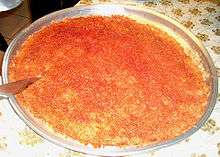
Kanafeh Nabulsieh originated in the Palestinian city of Nablus,[8][29] hence the name Nabulsieh. Nablus is still renowned for its kanafeh, which consists of mild white cheese and shredded wheat surface, which is covered by sugar syrup.[30] In the Levant and Egypt, this variant of kanafeh is the most common.
Kadayıf and künefe
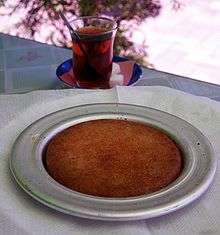
In the Hatay region of Turkey, which was formerly part of Syria and has a large Arab population, the pastry is called künefe and the wiry shreds are called tel kadayıf. A semi-soft cheese such as Urfa peyniri (cheese of Urfa) or Hatay peyniri (cheese of Hatay), made of raw milk, is used in the filling.[31] In making the künefe, the kadayıf is not rolled around the cheese; instead, cheese is put in between two layers of wiry kadayıf. It is cooked in small copper plates, and then served very hot in syrup with clotted cream (kaymak) and topped with pistachios or walnuts. In the Turkish cuisine, there is also yassı kadayıf and ekmek kadayıfı, none of which is made of wiry shreds.
Riştə Xətayi
This Azerbaijani variant is prepared in Tabriz, Iran. "Riştə Xətayi" consists of meshed shreds, and is typically cooked in Ramadan in the world's biggest covered Bazaar of Tabriz. It is made of chopped walnuts, cinnamon, ginger, powder of rose, sugar, water, rose water and olive oil.[32]
Kadaif
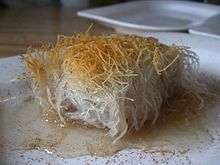
In this variant, called also καταΐφι (kataïfi) or κανταΐφι (kadaïfi) in Greek, the threads are used to make various forms of pastries, such as tubes or birds' nests, often with a filling of chopped nuts as in baklava.
World records
The world's largest plate of the dessert was made in Antakya, Turkey, in 2017. The tray of künefe measured 78 meters long, and weighed 1550 kilograms.[33] A previous record attempt was made by rival Nablus in 2009, with a 75-meter tray, weighing 1,350 kilograms.[34] Neither attempt was officially listed as breaking the record; according to the website of the Guinness World Records, there is no current record holder for the title.[35]
See also
- Ekmek kadayıfı, Turkish bread custard
- List of pastries
- Palestinian cuisine
- Phyllo
- Qatayef, a dumpling-like confection involving some of the same ingredients
Gallery
.jpg) Kanafeh in Jerusalem
Kanafeh in Jerusalem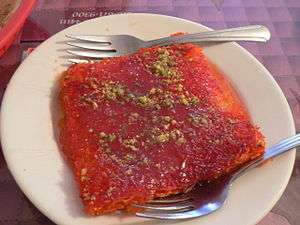 Kanafeh (na'ama) fine
Kanafeh (na'ama) fine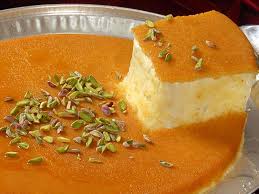 Kanafeh Nabulsieh
Kanafeh Nabulsieh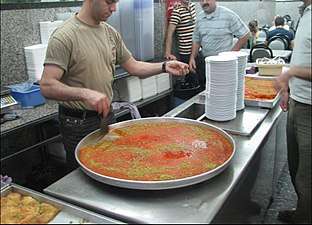 Kanafeh shop, Old City of Jerusalem
Kanafeh shop, Old City of Jerusalem
References
- Davidson, Alan (2014). The Oxford Companion to Food. Oxford University Press. pp. 33, 661–662. ISBN 9780199677337 – via Google Books.
- Perry, Charles (26 May 1999). "The Dribble With Pastry". Los Angeles Times. ISSN 0458-3035. Archived from the original on 7 December 2015. Retrieved 2018-07-12 – via LA Times.
- "Knafeh". Time Out Sydney.
- Albala, Ken (2016). At the Table: Food and Family around the World: Food and Family around the World. ABC-CLIO. ISBN 9781610697385.
- "Desserts". Palestine Ministry of Tourism & Antiquities. 4 December 2017.
- Albala, K. (2011). Food Cultures of the World Encyclopedia. 1. Greenwood. p. 311. ISBN 9780313376269. Retrieved 2014-12-02.
- Encyclopedia of food and culture. Scribner. 2003. p. 159. OCLC 50590735.
- Edelstein, Sari (2010). Food, Cuisine, and Cultural Competency for Culinary, Hospitality, and Nutrition Professionals. Jones & Bartlett Publishers. ISBN 9781449618117.
- Nasser, Christiane Dabdoub (2013). Classic Palestinian Cuisine. Saqi. ISBN 9780863568794.
- "Is Knafeh Israeli or Palestinian?". Haaretz. 4 June 2014.
- Tamime, editors, R.K. Robinson, A.Y. (1996). Feta and related cheeses. Cambridge, England: Woodhead Pub. ISBN 1855732785.CS1 maint: extra text: authors list (link)
- Magazine, Culture; Miller, Laurel; Skinner, Thalassa (2012). Cheese For Dummies. John Wiley & Sons. ISBN 9781118145524.
- "Bibliotheca Polyglotta". www2.hf.uio.no. Retrieved 2018-07-12.
- Marks, Gil (17 November 2010). "Kanafeh/Kadayif". Encyclopedia of Jewish Food. Houghton Mifflin Harcourt. ISBN 9780544186316 – via Google Books.
- Youssef, Aḥmad Abdel-Hamid (2003). From Pharaoh's Lips : Ancient Egyptian Language in the Arabic of Today. Cairo: American University in Cairo Press. pp. 46–47. ISBN 9781617974762. OCLC 897473661.
- Goldstein, Darra, ed. (2015). The Oxford Companion to Sugar and Sweets. Oxford University Press. p. 447. ISBN 9780199313396 – via Google Books.
- The Editors of the American Heritage Dictionaries. "Appendix II - Semitic Roots". American Heritage Dictionary. Houghton Mifflin Harcourt. Retrieved July 12, 2018.
- Team, Almaany. "Definition and meaning of Kanafeh in Arabic in the dictionary of the meanings of the whole, the lexicon of the mediator, the contemporary Arabic language - Arabic Arabic dictionary - Page 1". www.almaany.com.
- "Nişanyan Sözlük - kadayif" [Nişanyan Dictionary - kadayif]. Nişanyan Sözlük (in Turkish). Retrieved 2018-07-14.
- "Kunafa, Qatayef: Ramadan's most favorite desserts". Cairo Post. 6 July 2015. Retrieved 2018-07-12.
- Roufs, Timothy G.; Roufs, Kathleen Smyth (2014). Sweet Treats around the World: An Encyclopedia of Food and Culture. ABC-CLIO. p. 464. ISBN 9781610692212.
- Wright, Clifford A. (1999). A Mediterranean Feast: The Story of the Birth of the Celebrated Cuisines of the Mediterranean from the Merchants of Venice to the Barbary Corsairs, with More than 500 Recipes. William Morrow Cookbooks. ISBN 978-0-688-15305-2.
- Al-awsat, Asharq (4 October 2007). "The Ramadan Experience in Egypt - ASHARQ AL-AWSAT English Archive". ASHARQ AL-AWSAT English Archive. Retrieved 2018-06-18.
- Nasrallah, Nawal (2007). Annals of the caliphs' kitchens : Ibn Sayyār al-Warrāq's tenth-century Baghdadi cookbook. Brill. pp. 39, 43, 420. ISBN 9789047423058.
- "An Anonymous Andalusian Cookbook of the 13th Century". www.daviddfriedman.com. Retrieved 2018-07-12. See also contents and footnotes.
- Sato, Tsugitaka (31 October 2014). Sugar in the Social Life of Medieval Islam. BRILL. ISBN 9789004281561 – via Google Books.
- Isin, Mary (8 January 2013). Sherbet and Spice: The Complete Story of Turkish Sweets and Desserts. I.B.Tauris. pp. 193–194. ISBN 9781848858985 – via Google Books.
- "Kunafa". Sampateek. 9 October 2013.
- Abu Shihab, Sana Nimer (2012). Mediterranean Cuisine. AuthorHouse. p. 74. ISBN 9781477283097.
- Cuisine Archived 2007-08-04 at the Wayback Machine Institute for Middle East Understanding
- "Künefe – ein außergewöhnliches Dessert". nobelio.de. Retrieved 2014-12-02.
- Behnegarsoft.com. "اهراب نیوز - تصویری/ رشته ختایی؛ شیرینی مخصوص تبریز برای رمضان". ahrabnews.com. Archived from the original on 2014-10-06. Retrieved 2014-12-02.
- "78-meter-long künefe dessert eaten in 20 minutes in Turkey's Hatay". Hürriyet Daily News. Retrieved 2018-07-14.
- "WEST BANK: Palestinian Knafeh enters Guinness World Records". Itnsource.com. Retrieved 2015-05-21.
- "Search Results – Guinness World Records". Retrieved 2018-07-14.
External links
